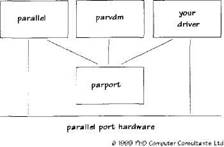Книга: Writing Windows WDM Device Drivers
NT Layering
NT Layering
Windows NT 4, NT 3.51, and 2000 use layers of NT style drivers. This is not the layering of Plug and Play devices seen in most of this book. Instead, each driver must be loaded in the correct order and use any existing drivers.
Parallel Port Drivers
As an example, Figure 19.3 shows the layering of the parallel port drivers. The parport driver is loaded first. parport arbitrates access to the parallel port hardware. The parallel and parvdm drivers are then loaded. When these drivers want to access the parallel port hardware, they must ask parport for access rights. Once access rights have been obtained, they can talk to the parallel port electronics directly.
New parallel port drivers should use the same technique to get access to the hardware[47]. The DDK recommends that you grab access to the port on a per-IRP basis. For most applications, I recommend taking control of the port for the duration of a larger transaction (e.g., while a handle is open to your device).
Figure 19.3 Parallel port layering

The parport driver creates a named kernel device object for each parallel port it finds. These device objects have kernel names starting with DeviceParallelPort0. Use IoGetDeviceObjectPointer to obtain a pointer to the relevant device object[48]. Store this in your device extension for later use.
The parport driver supports several Internal IOCTLs. IOCTL_INTERNAL_GET_PARALLEL_PORT_INFO returns information about the parallel port (the base register address and port allocation routines). When the information is safely stored away, a similar (but undocumented) IOCTL_INTERNAL_RELEASE_PARALLEL_PORT_INFO call is made to release the information.
Two port allocation routines are available. TryAllocatePort tries to allocate the port and returns straightaway. If this succeeds, FreePort is used (later) to return the port. Call TryAllocatePort when you want to start accessing a parallel port and FreePort when you are finished with it.
When you install a driver that uses the parport driver, you must make sure that your driver loads after parport has started. Do this by including a DependOnService string value in your driver's registry entry that is set to parport.
Microsoft may be introducing a new WDM architecture for these parallel port drivers. A parallel port bus driver would replace parport. It would enumerate the ports available on the "bus". This is particularly important, as several IEEE 1284.3 printers may be daisy-chained on a single parallel port connection. The header file parallel.h in the W2000 DDK srckernelinc directory gives a hint of how the new interface will work.




